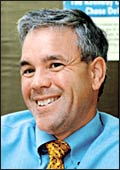 |
 |
| Dell Asia's Felice and Dell
India's Anandan: Setting a scorching pace of growth |
The
$56-billion (Rs 2,59,000 crore) Dell hasn't been having the best
of times globally. Slowing growth numbers, missed earnings forecasts,
the recall of 4.1 million Sony batteries in Dell notebooks, rumours
of CEO Kevin Rollins' (see "The pc Will Remain The Core Of
The Company", May 22, 2005) exit-the company's cup of woes
seems to be flowing over. Why, even the famous "Dell Way"
of selling directly to the end-customer is being questioned.
But in India, it has been good news all the
way. The company grew 64.3 per cent by volume and 50.9 per cent
by value in the second quarter of the current year-the fastest
growth rates among all hardware vendors-and is on course to touch
annual revenues of $400 million (Rs 1,880 crore) by the end of
the year. "India is now the third largest market in Asia
for Dell after Japan and China. This year, we have grown 64.3
per cent here compared to 31 per cent in China, though, admittedly,
from a lower base," says Steve Felice, President (Asia Pacific
and Japan), Dell Asia. Dell, the largest player worldwide, with
a 19.2 per cent share of the global pc market, is at #4 in India
(see Total Shipments of PCs In India). The probable reason: Dell's
direct selling model may not be working in a country where net
penetration is low and buyers feel comfortable buying from resellers.
Felice is quick to quash speculation that
Dell is considering moving away from the Dell Way in India. "There
is no such move," he says. For good measure, the company
has set its sights on becoming the market leader in the 4.8-million
unit, $4-billion (Rs 18,480-crore) Indian market "just like
we are worldwide," adds Rajan Anandan, VP & GM, Dell
India. As part of this plan, it is setting up a manufacturing
facility in India (its fourth in Asia after two plants in Malaysia
and one in China). Felice and Anandan refuse to confirm rumours
that it is coming up in Tamil Nadu. "The plant will be up
and running by the end of the calendar year and we intend to start
shipping PCs by the first quarter of 2007; this will improve our
turnaround times and responsiveness," they say. Initially,
the plant is expected to cater to the domestic market, but Felice
adds that it may later become a sourcing hub for other neighbouring
countries as well. There are rumours that Chairman Michael Dell
will visit India for the launch of this plant; but the company
would not confirm this.
Incidentally, Dell India does more than just
sell PCs. About 90 per cent of its 12,000-plus workforce is in
its technical support centres (call centres) in Bangalore, Hyderabad,
Gurgaon and Chandigarh. There have been complaints about the quality
of output from these centres; so, the company is planning to invest
$150 million (Rs 693 crore) to set this right. Says Felice: "Yes,
we have had some issues. However, the important thing is that
we have quickly moved to address these. Independent measuring
agencies have indicated that the results are already being felt
and seen." Dell is now expected to ramp up its numbers to
20,000 employees by 2008. And it will hire not just for its call
centres-its sales arm has tripled in size over the last nine months
to 600 people; this is expected to double over the next nine.
Its Indian R&D team of 300-its largest R&D team outside
of its main facility in Austin, Texas-is also expected to double
by the end of the year.
Anandan says Dell's India strategy revolves
not just around PCs. "We are growing in servers, printers,
services and storage as well and will continue to focus on all
of them."
That means the competition has been put on
notice.
Needles
And PNs
Ban participatory notes, says the
Tarapore panel. Yea, right.
 |
| S.S. Tarapore: Taking a tough stand |
The
six-member Tarapore Committee's report on fuller capital account
convertibility or FCAC (see Cry Freedom on page 48), quite unnecessarily
a section of market observers will agree, chose to focus on participatory
notes (PNs), those instruments used by foreign institutional investors
(FIIs) to invest on behalf of overseas clients who are not registered
to invest in India. Tarapore and his merry men want nothing less
than a resounding ban on PNS. Reports though indicate that the
powers that be in North Block (home to the Finance Ministry) aren't
exactly amused. After all, PNs are estimated to account for nearly
half of foreign inflows into the country. Unsurprisingly, the
Ashok Lahiri Committee report on liberalisation of FII investment
in June 2004, in fact, strongly suggested widening the scope of
PNs.
"No other country is bothered about
this PN issue," says a furious John Band, CEO, Zoom Cortex,
which advises FII clients. "India today competes for capital
in the global market and a ban doesn't serve any purpose."
One of the non-bank committee members, Surjit Bhalla, did dissent
the PN ban. "A ban on PNs is what RBI also wants. That's
the problem," argues Bhalla, Managing Director, Oxus Research
& Investments. The flipside, though, is that the regulators
are worried about the nature of the foreign inflows from unregistered
participants. However, the market's further northward movement
in the days subsequent to Tarapore's report only indicated how
seriously investors regarded the proposal.
-Anand Adhikari
Cry Freedom
Another route map on CAC raises the same
old fears.
The
roadmap is well laid out, but the signposts are missing. That's
how the second Tarapore Committee report on fuller capital account
convertibility (FCAC) can be best described. CAC involves the
freedom to exchange domestic currency with other international
currencies and vice versa. A few months ago, Prime Minister Manmohan
Singh, in a speech at a Mumbai function, hinted at the need to
revisit FCAC in the light of buoyant economic conditions. Y.V.
Reddy, Governor, Reserve Bank of India (RBI), took the cue and
got retired banker S.S. Tarapore to pen down a report-Tarapore
has a bit of experience on formulating theses on CAC; he wrote
a tome on it in 1997, but most of his recommendations were duly
dumped by the mandarins on Mint Street. His new 204-page opus
may not fare much better.
One of Tarapore's preconditions for moving
into CAC in 1997 was fiscal management, but many of those milestones
haven't yet been reached. The target set by the Tarapore Committee
was a reduction in the fiscal deficit as a percentage of GDP (gross
domestic product) from a high of 5 per cent in 1997 to 3.5 per
cent by 1999-2000. In 2006, the fiscal deficit is still at 4.1
per cent. The target set for the cash reserve ratio (CRR) was
3 per cent, but still CRR rules at 5 per cent. Gross NPAs (non-performing
assets) needed to settle at 5 per cent. Today, that figure is
a tad higher at 5.2 per cent.
A few of the old fears have been once again
touched on-like, for instance, the flight of capital overseas.
V.P. Singh, Director at Deloitte Touche Tohmatsu India, argues
that India is attracting capital from all over the world. "I
don't see any reason why the capital would fly out in a CAC regime.
In fact, the capital movement coupled with sustained economic
development will take care of the fiscal deficit in the longer
run." The report says while the reserves of $164 billion
(Rs 7,70,800 crore) will be comfortable to take care of external
liabilities, there are concerns about the coverage of debt on
short term debt, including suppliers' credit. "Given the
restrictions today, the reserves look adequate, but the real test
will be when you open up the market," points out J. Moses
Harding, Executive Vice President, IndusInd Bank.
In a CAC regime, the committee has ambitiously
suggested the minimum shareholding of the government in leading
public sector banks should go down from 51 per cent to 33 per
cent. Did you need another FCAC report to tell you that?
-Anand Adhikari
The KP Effect
Heads that 'played' a role in the 2001 scam
have rolled.
 |
| SBIMF's Niamatullah: In CBI's net |
Barely
had the road shows begun to rumble than Lotus Mutual Fund suffered
a major setback last fortnight, when Sandip Sabharwal, Chief Investment
Officer (Equity) quit the organisation. Reason? The Central Bureau
of Investigation (CBI) filed a charge-sheet against him, as well
as his former colleagues who comprised the investment committee
at SBI Mutual Fund, for his alleged role in the stock market scandal
of 2001. CBI after its investigation also charge-sheeted Niamatullah,
the former MD of SBIMF and 32 others, including Rajat Jain, CIO,
Principal PNB Mutual Fund; Ajay Bodke, Fund Manager, Standard
Chartered Mutual Fund; and Sabharwal before the sessions court.
The case pertains to the purchase of shares of Padmini Technologies
(formerly Padmini Polymers) by sbimf during the securities scam
of 2001. The case will come for hearing on September 8.
The alleged lynchpin of the stock fraud is,
of course, Ketan Parekh, and Padmini Technologies is just one
of the many stocks he is alleged to have manipulated. The SBIMF
investment committee is said to have bought 22 lakh shares of
Padmini Technologies through an off-market purchase at Rs 165
each in February 2000 from KP-controlled firms. The deals were
allegedly in violation of stipulated norms and ended up making
a loss of Rs 60 crore in SBIMF's books when the stock price subsequently
plunged.
Other companies implicated in the KP fraud
by a Joint Parliamentary Committee set up to throw light on the
scandal include business groups like Adani, HFCL, DSQ, Cadila,
Essel, Kopran and Nirma, who are said to have funded KP during
the January 2000-April 2001 period. The amount outstanding from
KP to these entities is over Rs 1,237 crore. Little has been proved
so far, though. KP is banned from the capital markets, but enquiries
by sundry agencies against him are still under way. But the bit
players are now beginning to pay the price.
-Mahesh Nayak
|








